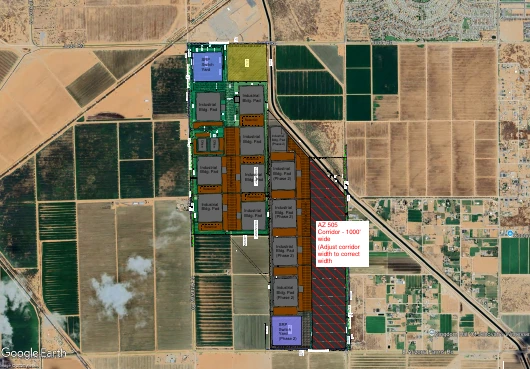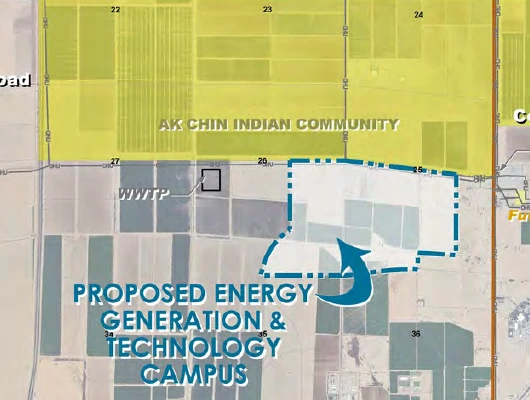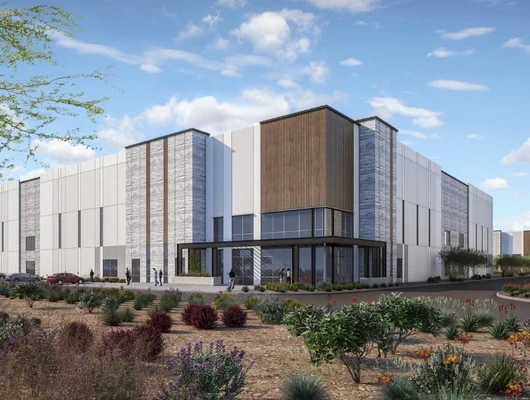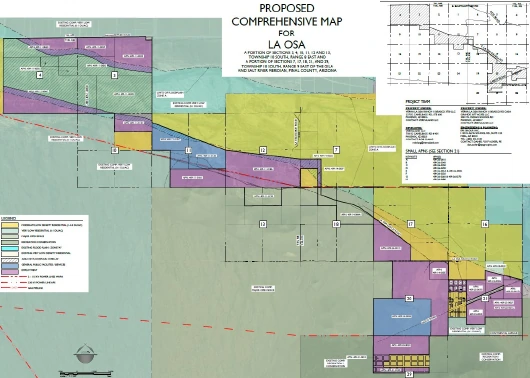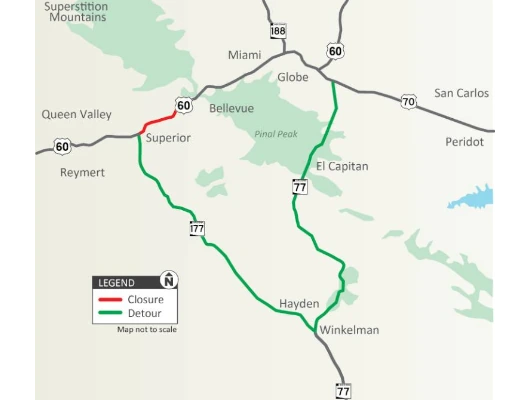Key Points
- 1,619 acres rezoned: The Florence Town Council voted 7-0 on October 7, 2025, to rezone large portions of the Dobson Farms master plan from residential to industrial use.
- Three development areas: The approvals cover Florence Tech Park (780 acres), Dobson Farms West (600 acres), and Dobson Farms East (239 acres) — together forming one of Arizona’s largest planned data center corridors.
- Massive power demand: Combined electrical needs could approach 1 gigawatt, supported by the nearby SRP Abel Substation and future transmission upgrades.
- Economic impact: The projects are projected to create about 800 jobs, $10 million in annual tax revenue, and fund $2 million in roadway improvements.
- Water efficiency: Industrial use will consume roughly one-third the water of the previously planned residential project.
- Strategic location: Sites lie along future alignments of the Central Arizona Parkway and North–South Corridor (SR-505L), making them well positioned for logistics and energy access.
- Minimal public opposition: The projects advanced through hearings with strong council support and little resident opposition.
Council votes 7-0 to rezone former residential land for data centers and industrial development
The Florence Town Council voted unanimously on October 7, 2025, to approve three major land use amendments transforming 1,619 acres of the Dobson Farms master-planned community from residential to industrial development.
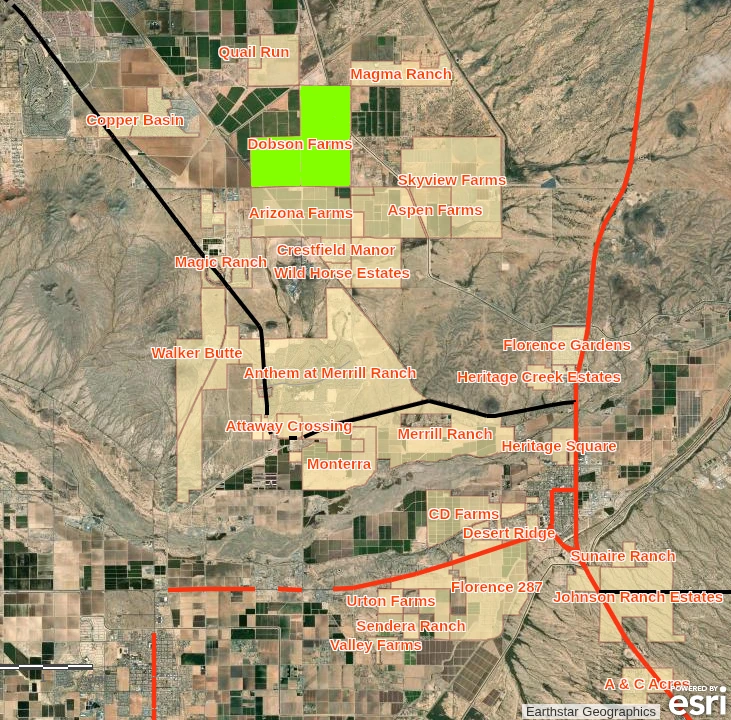
The Projects: Three Development Areas
The approved amendments divide the development into three separate areas: Florence Tech Park, Dobson Farms East, and Dobson Farms West.
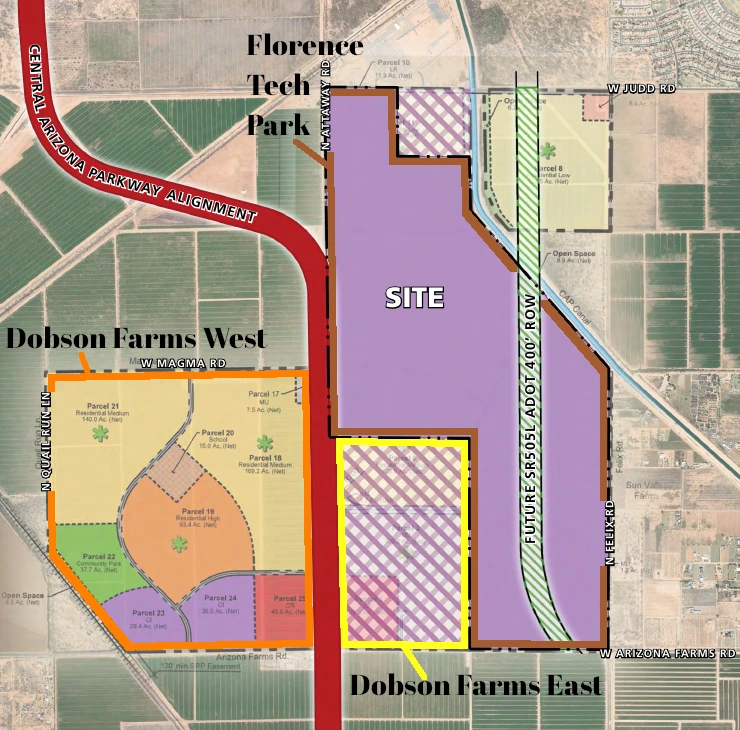
Development Area 1: Florence Tech Park (780 acres) sits at the southeast corner of Judd Road and Attaway Road. Preliminary plans show the project will feature five data centers, two office buildings, and one general industrial building. Final building counts remain subject to detailed site planning. Ryan Companies US, Inc. is developing this property.
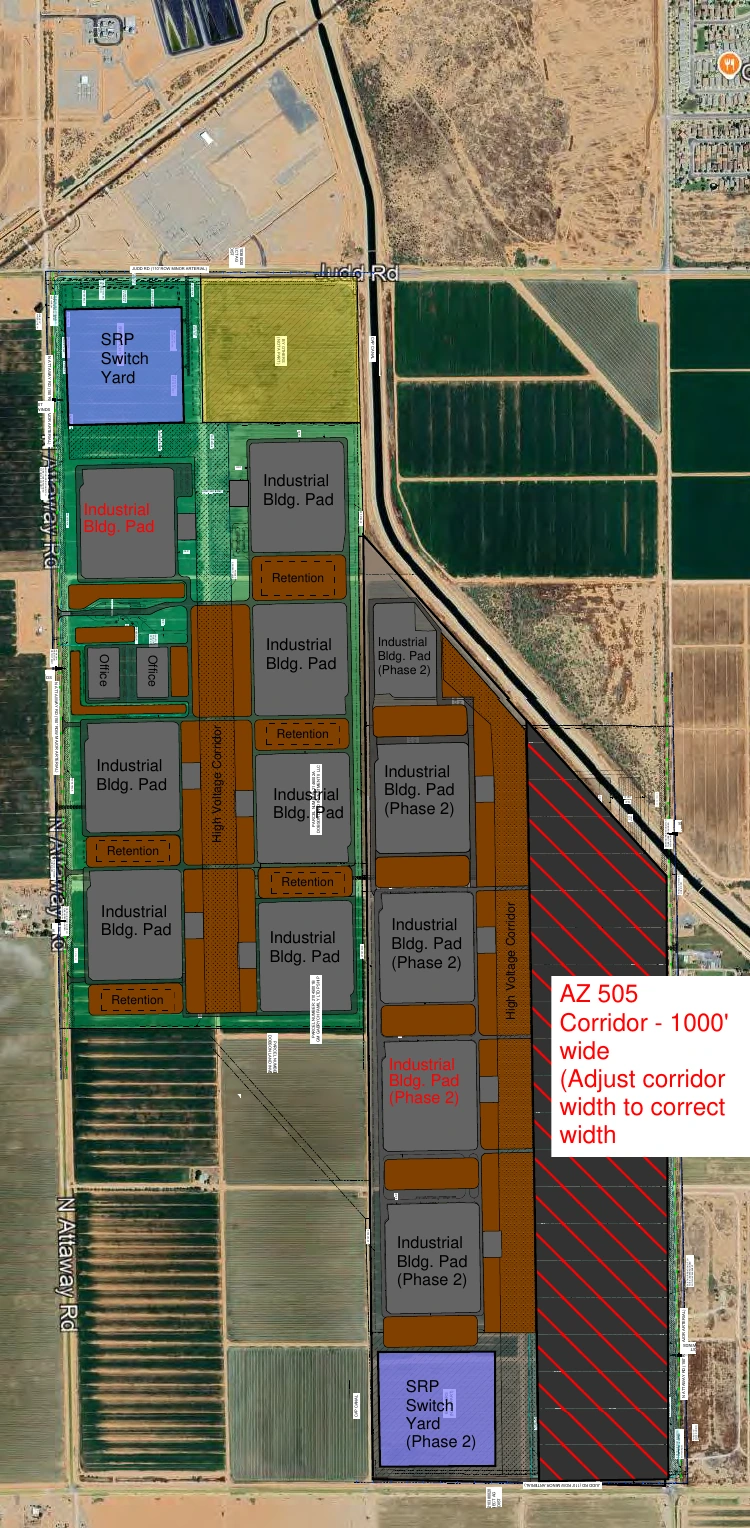
Development Area 2: Dobson Farms East (approximately 239 acres) occupies the northeast corner of Arizona Farms Road and Attaway Road. Conceptual plans submitted by the developer show 10 two-story data center buildings, each with approximately 72 megawatt power capacity. This totals roughly 720 MW for this site. Plans include multiple high-capacity electrical substations—three large and one smaller—plus 44 backup generators.
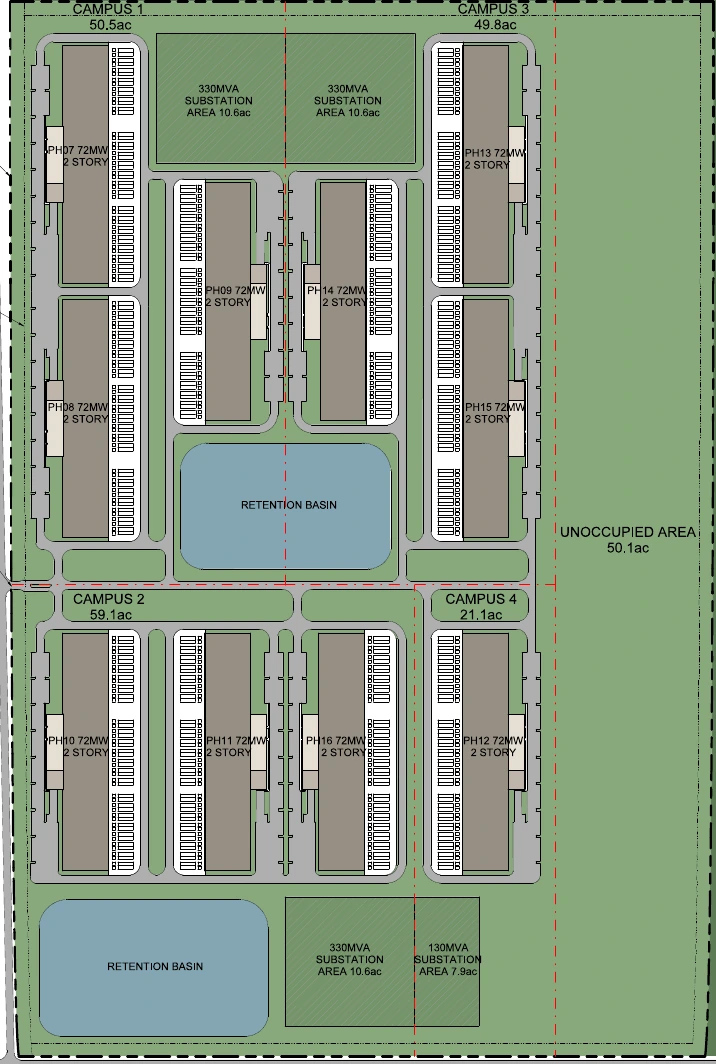
Development Area 3: Dobson Farms West (600 acres) sits at the northwest corner of Arizona Farms Road and Attaway Road. The site will accommodate large-scale data centers and industrial/warehousing facilities.
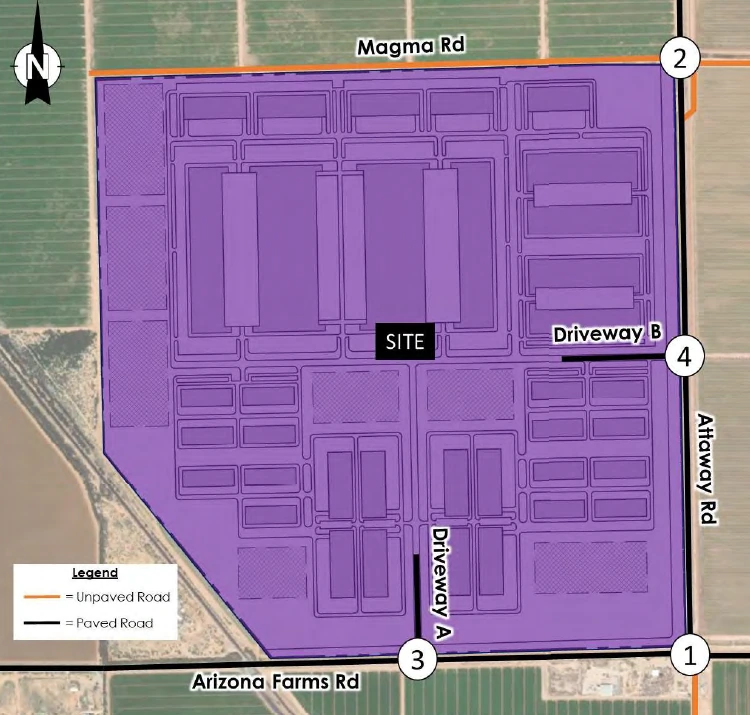
Together, the three projects could require electrical demand exceeding 1 gigawatt. To provide scale, the Palo Verde Nuclear Generating Station—the nation’s largest power plant—averages 3.3 gigawatts of production. This makes the Dobson Farms development one of the most power-intensive projects in Arizona.
Strategic Location and Infrastructure
The development sites benefit from proximity to major infrastructure. The Abel SRP substation sits directly north of Florence Tech Park, providing the massive electrical capacity required for data center operations. Garry Hays, representing Ryan Companies, emphasized this advantage: “It’s important to note that right across the street from this project is also a very large substation. I think one of the largest in Pinal County.”
The planned North-South Corridor (SR505L) freeway and Central Arizona Parkway will border the properties, with the parkway expected to traverse along Attaway Road. Hays noted developer confidence in the parkway’s construction despite the freeway’s uncertain timeline.
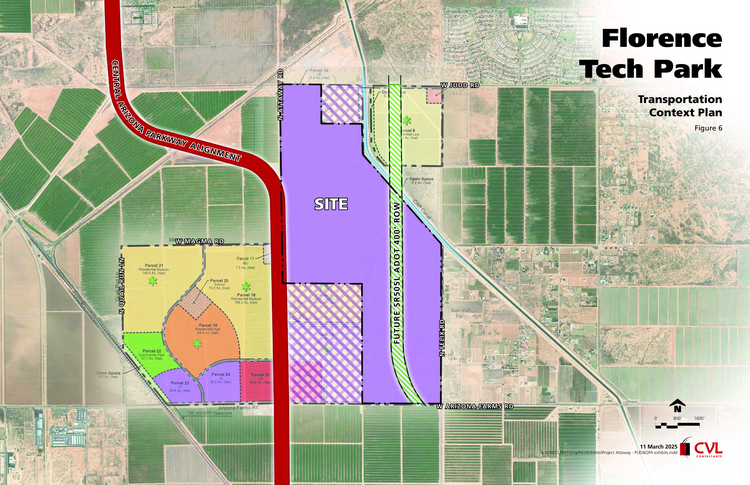
From Residential Vision to Industrial Reality
The original Dobson Farms PUD received approval in 2009 with approximately 1,810 acres designated for residential development. After 15 years without development, changing market conditions prompted the shift to industrial uses. The 2022 Florence General Plan update changed the site’s designation from Master Planned Community to “Suburban Neighborhood”—a primarily residential category—creating the need for major amendments to pursue industrial development.
Council Addresses Community Concerns
Mayor Keith Eaton outlined how the projects address three primary citizen concerns: “What I hear personally, is that our citizens are worried about water, they’re worried about traffic that we can’t put onto the present roads as we work through expanding them, and then we worry about jobs. These projects in the future have a propensity to answer all three of those questions.”
The mayor emphasized that the industrial development will recover two-thirds of the water previously allocated for residential use. He noted this becomes particularly important as water limitations will constrain future development throughout the southwest. Eaton also explained how the SR505L corridor makes the land less suitable for residential development, since many people don’t want to live next to a freeway.
Vice Mayor Cathy Adam emphasized the project’s benefits: “Everything leads us to say, it’s best for water, it’s good for jobs, it’s good for our roads.”
Councilmember Nicole Buccellato called it “the perfect area for something like this, especially with the battery storage that we approved a couple council meetings ago.”
Councilmember Jose Maldonado declared the decision straightforward: “I think this is a no-brainer. This is something that has been a long time coming. It’s a prime location for it and it’s a win-win.”
Projected Economic and Infrastructure Benefits
Julie Vermillion of CVL Consultants presented projected benefits from the developments at full build-out:
- Approximately 800 jobs created
- $10 million in annual tax revenues for Florence
- $500,000 in development impact fees for police
- $1.4 million for fire department funding
- $2 million for roadway improvements
These figures are planning-level estimates subject to adjustment based on future fee schedules and development phasing.
The industrial development will consume approximately one-third the water of the originally planned residential project. This reduces demand from three million gallons per day to about one million gallons per day.
Traffic generation will decrease compared to residential development. Developers committed to constructing major widening and signal improvements along Attaway, Judd, and Arizona Farms Roads, with turn lanes and traffic signals as determined by traffic studies
Educational Component Raises Interest
The permitted uses list includes an addition that caught staff attention: technology college, university, or technical school. Hays explained the rationale: “When you have these hyperscalers come in, they set up classrooms because they will bring people from all over the country to teach them how to do it, and then we want to have the ability for them to come to the town of Florence to teach people how to go out to the rest of the country to run these data centers.”
Councilmember Tony Bencina expressed enthusiasm for this aspect: “I was excited seeing technical college too. I’m real excited about the project.”
Dobson Family’s Perspective
Chris Dobson addressed the council, referencing conversations with former town leadership about industrial development needs six years ago. “I kept that in mind, and when the opportunity presented itself, this popped up. I was like, ‘You know, this is something that would be good for the town.’ I’m very bullish on the town of Florence. It’s a beautiful place, and we’re just thankful that we have such a great staff and a great city council, and a really good community.”
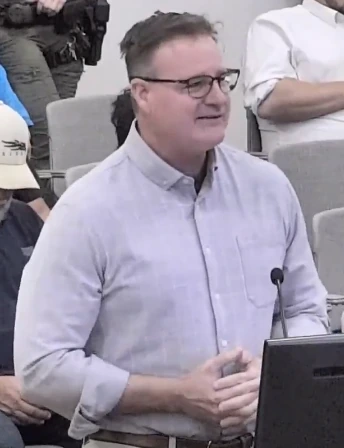
Mayor Eaton acknowledged the family’s contributions: “The Dobson family has given so much to this town and continues. Thank you for giving some industrial back to us.”
Bonnie Bariola, speaking during public comment, commended the Dobsons “for thinking forward and annexing to the town of Florence many years ago, instead of remaining in Pinal County. Florence is getting to take advantage of these developments.”
Minimal Public Opposition
Throughout the process—including neighborhood meetings and multiple Planning and Zoning Commission hearings—the projects faced virtually no opposition. At the Florence Tech Park neighborhood meeting, Hays reported that five residents and two planning commissioners attended. “Literally they were just like, ‘Can you hurry up and build it?’ That was the comments that we got at the neighborhood meeting.”
The Town Council’s October 7 public hearings drew only two public comments, both supportive. No one spoke in opposition at any stage of the approval process.
Vice Mayor Adam emphasized the importance of public input: “My main interest in it is to hear from the public. It’s a public hearing for the neighbors and our community to come in and speak up. I’m very happy to say that there has been very little negativity towards this rezoning project.”
Development Standards and Guidelines
The Florence Tech Park PUD amendment allows building heights up to 60 feet for light industrial uses and 85 feet for data centers. The taller height accommodates the technical requirements of data processing facilities.
New permitted uses include data centers, energy production and storage, technology research facilities, laboratories, and advanced manufacturing. The amendment also permits outdoor storage yards, service bays, loading docks, and transformer stations to support industrial operations.
Water Technology Evolution
During earlier Planning and Zoning Commission hearings in September, concerns arose about data centers consuming large amounts of water. Hays clarified that technology has evolved significantly. “They used to be water heavy, they’re no longer water cooled. They’re all electric,” he explained. “So that is about eight to 10 year old technology. They don’t do that anymore because they can’t. So now they are more electricity eating animals.”
Next Phase
The development team coordinated with county staff regarding the SR505L and Central Arizona Parkway impacts. Salt River Project administrative staff requested involvement in reviewing project plans to ensure electrical infrastructure compatibility.
The council approved Ordinances 766-25, 767-25, and 768-25 for the three General Plan Amendments, along with Ordinance 769-25 for the Florence Tech Park PUD Amendment. The approvals clear the way for preliminary engineering, architectural, and site planning documents. Developers will submit detailed plans for Town Engineer and Planning and Zoning Commission review as each phase advances toward construction.
